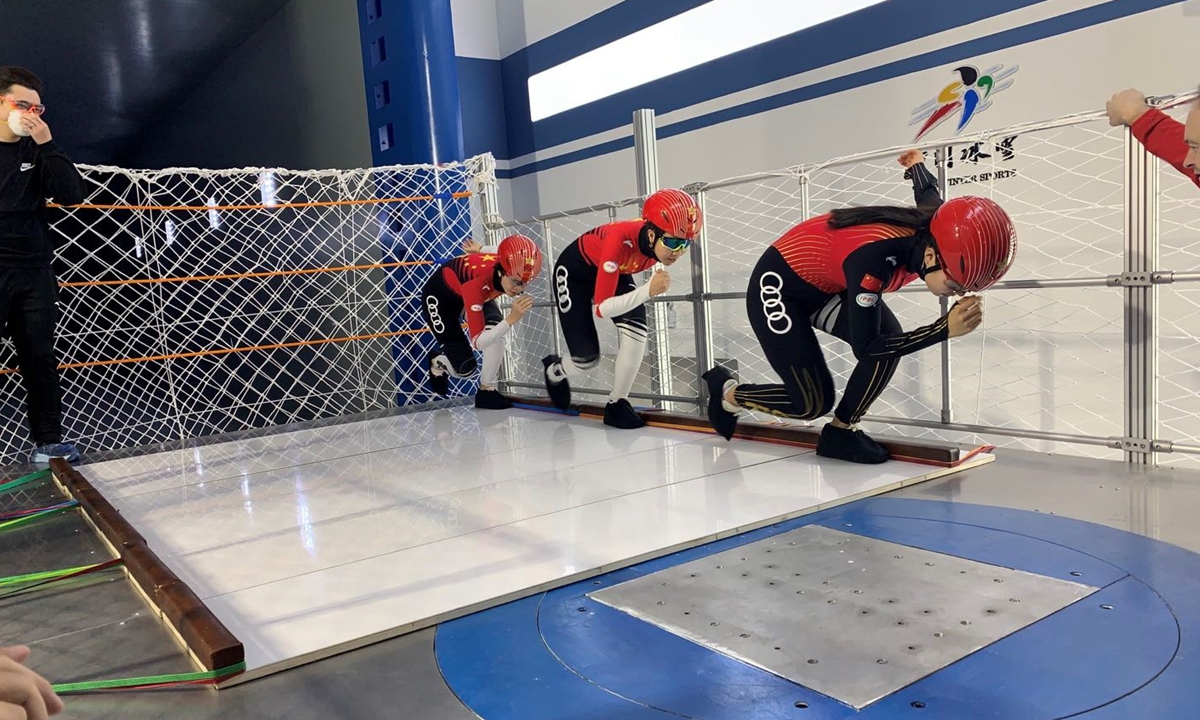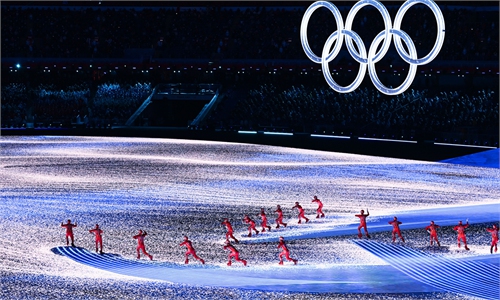How China’s successful athletes were ‘blown’ out of the wind tunnel like the ‘Dongfeng Express’

Photo:GT
On Saturday night, the first highlight of the Beijing 2022 Winter Olympics came for the Chinese team when Qu Chunyu, Fan Kexin, Wu Dajing and Ren Ziwei crossed the finish line in 2:37.348 to win China's first gold medal at the Beijing Winter Olympics.
On a track in pursuit of the ultimate human speed, milliseconds are the difference between victory and defeat. In high-speed short track speed skating, athletes' movements and small changes in posture can affect the speed. This is, to some extent, the same as the aerodynamic layout of aircrafts: The fastest speed can be achieved by maintaining the structure with the least air resistance.
Therefore, the value of a training artifact to help the Chinese short track speed skating team to explore the perfect posture to reduce wind resistance in this competition about speed was served to highlight. Until now, this artifact has been playing an extremely important role in another mysterious field - the design of China's missiles, rockets and aircraft. This artifact is the wind tunnel technique.
Ahead of the opening ceremony of the Beijing 2022 Winter Olympics, the Global Times reporters visited the China Academy of Aerospace Aeronautics (CAAA), the country's first large-scale aerodynamics research and test site, to explore the sports wind-tunnel project designed and built by the Academy for the General Administration of Sport of China. Athletes in a large number of sports, including swimming, rowing and cycling, also experienced the sports wind tunnel at the Tokyo 2021 Olympics.
In 2019, the General Administration of Sport of China deepened cooperation with the CAAA, which designed and built China's first sports wind tunnel for athletes preparing for the Beijing 2022 Winter Olympic Games. The sports wind tunnel, which was completed in 2020, has a diameter of 2.5 meters and is 3 meters high, with a test section of 8 meters long, and a designed wind speed of 151.2 km/hour, equivalent to a strong typhoon of category 14, Wang Kaiwen, Party chief of the institute, told the Global Times. "After it was completed, some of the Olympic athletes in Tokyo also used the wind tunnel to improve their performance," Wang said.
Zheng Liu, an engineer who participated in the design of the wind tunnel, told the Global Times that the designers researched a lot of games. The length, width and height of the wind tunnel were determined after comprehensively considering the size of the sports equipment for various Winter Olympic events, such as bobsleigh, luge and snowboard.
However, the reduction of wind speed does not mean that the development of sports wind tunnel will be correspondingly less difficult. Because the sports wind tunnel is mainly used by athletes, its accuracy, safety and comfort requirements are higher than a military wind tunnel. Li Yuqiu, a research fellow at the military-civilian integration office of the CAAA and a member of the expert team of the integrated sports training wind tunnel, said that every athlete that enters the wind tunnel is a "national treasure." In order to ensure their safety, the sports wind tunnel specially enhanced safety measures, such as trying to avoid the use of screws and others easy to fall off fasteners in the wind tunnel to prevent injury.
In addition, in order to facilitate the final selection of athletes' motion posture, the sports wind tunnel also has the function of shooting and storage, which can store the data of force measurement, picture data, center of gravity capture, and the change in the center of gravity after athletes change posture, providing a reference for coaches' guidance.
Why can athletes' performances be significantly improved after a period of training in the sports wind tunnel? Zheng Liu told the Global Times that wind tunnels are mainly used to test athletes' wind resistance in Winter Olympic speed events. The lower the wind resistance, the faster the speed, and the less energy the athlete has to use.
The Global Times learned that the force sensors in sports wind tunnels are sensitive enough to detect a change of 0.1 newtons and the effect of any small change in the athlete's resistance can be measured precisely. "Our goal is to find the best posture for the athlete and create the least resistance to increase his speed," Li said.
Li told the Global Times that although the application of wind tunnel technology in sports may sound a bit magical, China's application of wind tunnel technology was relatively late, as Western countries such as the US, Japan and Sweden had applied the technology to their athletes' daily training as early as in last century. However, thanks to the rapid development of China' space technology, China's sports wind tunnel technology has completely surpassed that of the Western countries.
"We can say that our overall technology level is already leading the world," Li noted.



